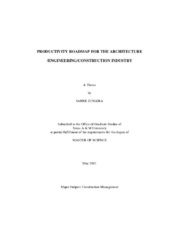| dc.description.abstract | The construction industry is one of the largest industries in the United States and has major influence on the nation's economy. While there is information about industry-wide labor productivity, there has been very little specifically aimed at analyzing the key macroeconomic factors such as labor productivity and gross margin of the construction industry as a whole and at fourteen of its sub-sectors. To address these shortcomings, the objectives of this research are threefold: (1) quantify the macroeconomic performance of the industry as a whole and at fourteen of its sub-sectors in terms of labor productivity, gross margin, and labor wages, (2) investigate the relationship among the three key parameters over the study period from 1992 to 2007, and (3) develop a quantifying model that predicts the level of a firms' profit as a function of such parameters. In addition, the paper seeks to further examine the interdependence between gross margin and labor productivity and wages by looking at the construction industry as a whole. First, data were collected from the 1997, 2002, and 2007 U.S. Economic Census reports generated by the U.S. Census Bureau. This raw data had discrepancies because of some missing values in data fields. This problem was then resolved by performing a bi-variate linear regression. Second, a one-way ANOVA and a general linear regression analysis was performed to investigate whether there was a statistically significant relationship among gross margin, labor productivity, and labor wages per construction worker. Third, a quantifying model was developed to predict the value of gross margin as a function of key parameters. Lastly, the proposed model was then validated with actual values of gross margin observed in three states, California, Florida, and Texas. The results of this research clearly indicate that there was no statistically significant relationship between labor productivity and labor wages per construction worker. In addition, it was seen that there was no significant relationship between labor wages and gross margin per construction worker. However, this study proved that there was a statistically significant relationship between labor productivity and gross margin per construction worker, which suggests the importance of labor productivity. The validation study proved the reliability of the proposed model in predicting the value of gross margin, with little deviation. This study concludes that sub-sectors experiencing higher labor productivity resulted in more profits as represented by the level of gross margin. This finding conveys the important fact that as labor productivity improves, firm's profits also increase significantly. It is noticeable to find that the construction industry as a whole had experienced a steady increase in its labor productivity and gross margin over the study period. | en |


